Jesus is a dead alien; Satan is a prehistoric sentient ooze; and “God” is the greatest supervillain of all time. This unique fictional theology helped me think outside the box, for sure!
It probably isn’t fair that so many of my favorite films are John Carpenter (or Carpenter-related) movies; but it happens to be true, and I’m sure no one is surprised by this. I’ve already discussed three of these flicks—Halloween (1978), The Thing (1982), and Halloween III: Season of the Witch (1982)—but one of Carpenter’s lesser known masterpieces is Prince of Darkness (1987), in which the creator of Michael Myers gives us his version of “the devil.” And it is the single most original and engaging take on the subject I have ever seen. If you’re expecting to see anything like Tim Curry with big ass goat horns, or even Al Pacino leading a law firm, think again. In Carpenter’s Prince of Darkness, everything we think we know about “Satan” is thrown out the window, and what turns out to be true about him is far more terrible than anything conjured by biblical scholars or Christian theologians.
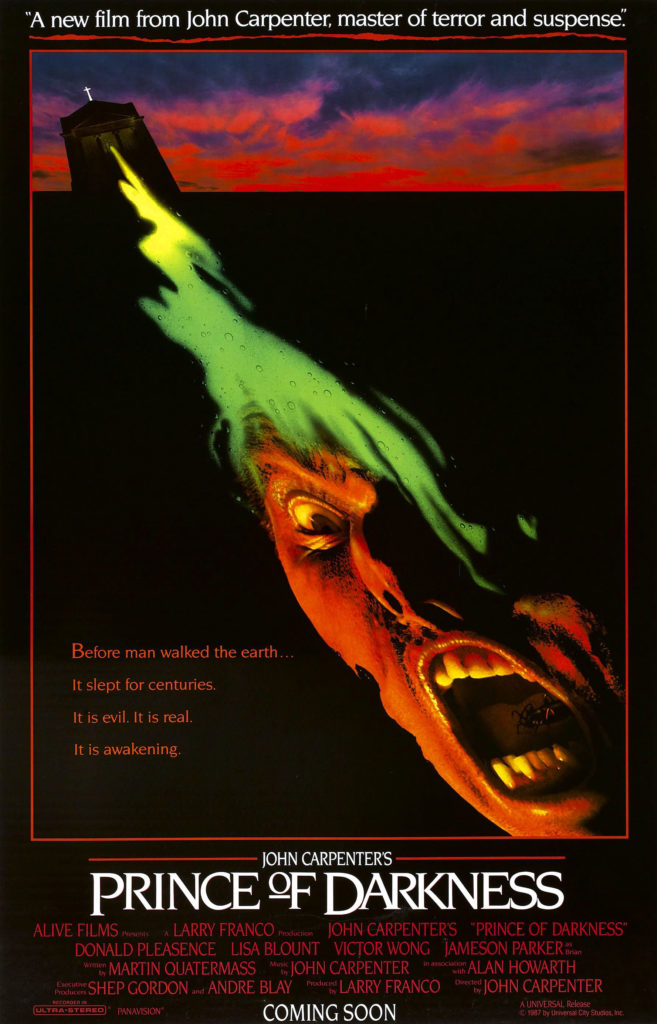
Professor Howard Birack (Victor Wong) is a world-renowned quantum physics lecturer at Kneale University, and his graduate students are some of the best and brightest young minds in his field. There’s Brian (Jameson Parker, who resembles a younger version of Tom Atkins in Halloween III); Catherine (Lisa Blount, a mathematician); and Walter (Dennis Dun, a total wisecracker), among others. These up-and-coming scientists are all bewildered by their instructor, who creeps them out with tales of how our human notions of “common sense” break down at the subatomic level, evaporating into “ghosts and shadows.” Perhaps it wouldn’t be so spooky to hear such things if there weren’t so many weird astronomical phenomena happening lately. Something about the lunar cycle seems different, and there’s also a newly discovered supernova being reported on TV. Some distant star died countless eons ago, and the particles from that explosion are only just now reaching our galaxy.
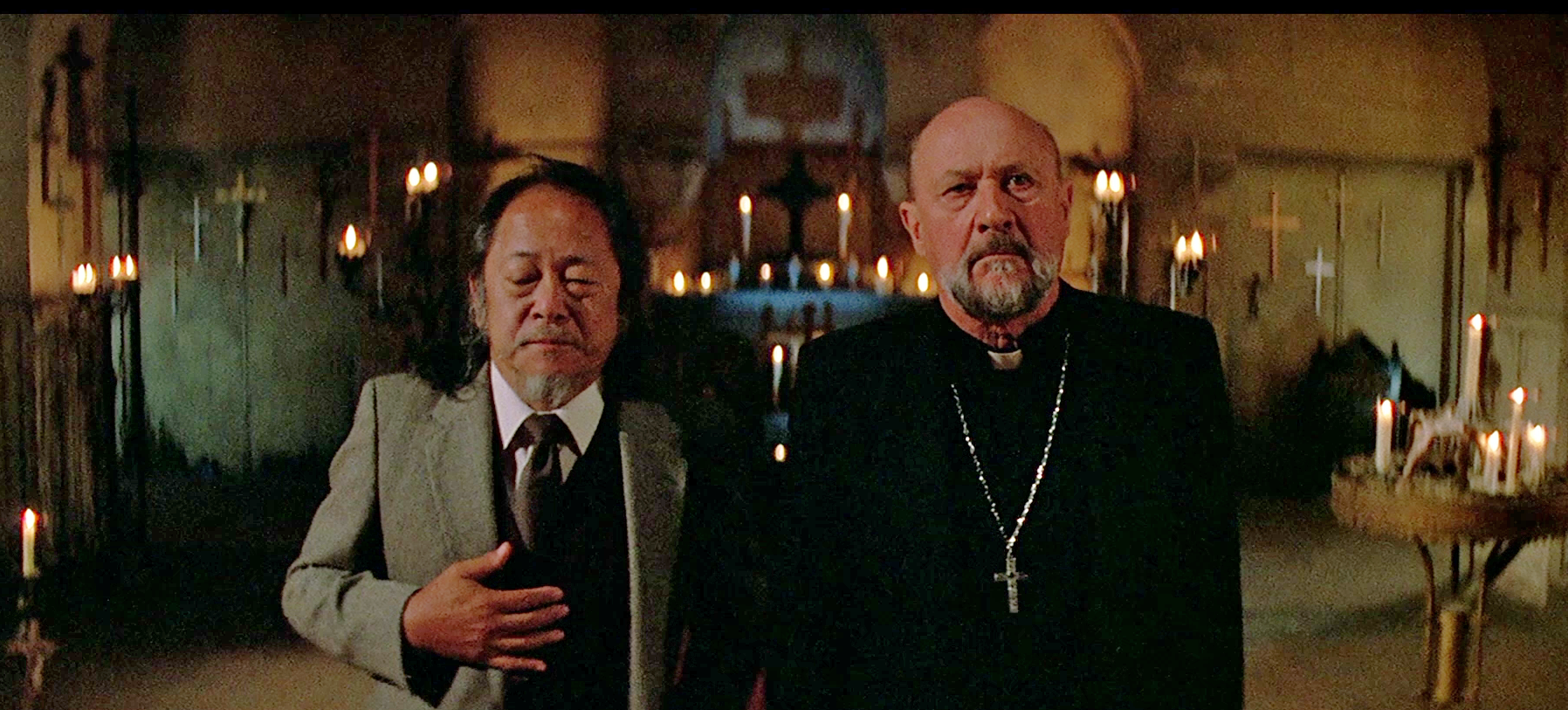
Then a Catholic priest (the magnificent Donald Pleasence) requests to meet with Professor Birack. The Priest claims he has made a terrible discovery, and he asks for Birack’s help in doing something about it. Birack accompanies the Priest to an abandoned derelict church called St. Goddard’s. As they descend into the church’s labyrinthine cellar, the Priest explains that he was on his way to visit another clergyman, who unfortunately died before the Priest could arrive. After reading his departed colleague’s diary, the Priest learned he had been living alone at St. Goddard’s, keeping something hidden in the basement. The clergyman was part of a sect so secret and powerful that even the Vatican doesn’t question its actions. Known only as “the Brotherhood of Sleep,” the sect has protected whatever the clergyman has been hiding at St. Goddard’s all this time. The clergyman was the last remaining member of the sect, and now that he has passed away, the Priest feels it is his duty to continue the Brotherhood’s work somehow.
When Birack and the Priest reach the center of the basement, they find a shrine decorated with countless crucifixes, all of which surround an object that stops Birack cold in his tracks. It’s a huge container filled with a swirling, glowing green ooze, and something about that ooze makes both men feel like they are being WATCHED. When Birack asks the Priest what this object might be, the Priest refers to it with masculine pronouns (“he/him”), as if it were a sentient entity. He also suggests it might have something to do with the moon and the supernova, and that some even crazier bullshit might be ahead. Is there anything Birack can do to help get rid of this fucking thing?

After coming to terms with this encounter, Birack approaches his students with a one-time offer: a unique opportunity to study this crazy discovery and write a whole bunch of academic papers from it. He also wrangles a few other professors and their students into this plan as well. The team assembles one Friday afternoon at St. Goddard’s, where everyone gets a good look at the strange container in the basement. Suddenly no one wants to be there anymore, but they stick around just the same, working and gathering data from the artifact into the wee hours of the night. As they do, some homeless people who have been hanging around the church start behaving like Michael Myers, standing unnaturally still and staring in hostile silence. (One of them is even played by Alice Cooper, who wrote “Prince of Darkness” [from his 1987 album, Raise Your Fist and Yell] for the soundtrack.)

The scientists take turns napping through the night, and whenever they sleep, they each have the exact same dream: a vision of a TV recording someone has made. The footage shows a hideous figure lurking in front of the church in which they are now sleeping. There is also a distorted voice in the nightmare that says:
“We are using your brain’s electrical system as a receiver. We are unable to transmit through conscious neural interference. You are receiving this broadcast as a dream. We are transmitting from the year 1-9-9-9. You are receiving this broadcast to alter the events you are seeing. Our technology has not developed a transmitter strong enough to reach your conscious state of awareness. But this is not a dream. You are seeing what is actually occurring. This is not a dream.”

When the scientists carbon date the container downstairs, they learn that its mineral content is over seven million years old, and that it came from outer space a well. There is an opening mechanism at the top, but strangely the lid can only be opened FROM THE INSIDE. No analysis of the glowing green ooze can be made, but everyone starts to feel it is ALIVE and WATCHING them somehow.
The team also finds an ancient Brotherhood of Sleep manuscript that appears to contain differential equations—several centuries before such mathematics were previously thought to have been invented! According to this text (which also appears to pre-date the New Testament), Jesus Christ was not a supernatural being, but an extraterrestrial from another planet in some distant galaxy. Jesus escaped from his homeworld when the sun of his solar system went supernova, and he reached our earth thousands of years later, landing in Roman-occupied Judea. There, Christ went around using his advanced alien medical science to heal people. He also tried to warn everyone about what destroyed his home planet. The aliens from Jesus’ homeworld discovered there is indeed a Universal Mind that can control the behavior of subatomic particles across all of time and space. But rather than a loving Creator, this Supreme Being is a wrathful Destroyer, seeking not to sustain but to annihilate all things.

This all-powerful Anti-God was somehow “banished” to the realm of anti-matter by Jesus and his people with their incredible technology; but this process required destroying their own sun for some reason (hence the supernova). Unfortunately, the Anti-God knew what was going to happen and created a “son”—Satan—which it buried in suspended animation on our planet, somewhere in the Middle East. Christ came to Earth specifically to find Satan and help the human race get rid of him; for when the devil wakes up, he will cause reality to unravel, allowing the Anti-God to slither back into our universe. But then Jesus was crucified, and the responsibility for all of this fell to the Brotherhood of Sleep. They found Satan and kept him hidden for all these centuries, hoping he would stay asleep until humans could develop a science sophisticated enough to destroy him. They eventually transported him here to St. Goddard’s, where the devil has been buried ever since.
No one really wants to come out and say it; but after hearing all of this, everyone knows exactly what—and more importantly, WHO—it is that’s watching them from inside that container down in the basement.
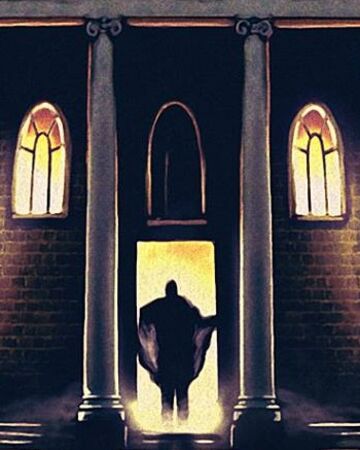
Then the scientists realize they have each been having the same nightmare. The Priest explains that historically, everyone who encounters the Brotherhood of Sleep starts to have this dream every night for the rest of their life. Brian and Catherine theorize that the dream might actually be a real message from the future, sent backward in time by scientists via “tachyon beam” signals that our brains can only receive as dreams. The message makes it clear that if something isn’t done about the entity trapped downstairs, the world will somehow end in 1999.
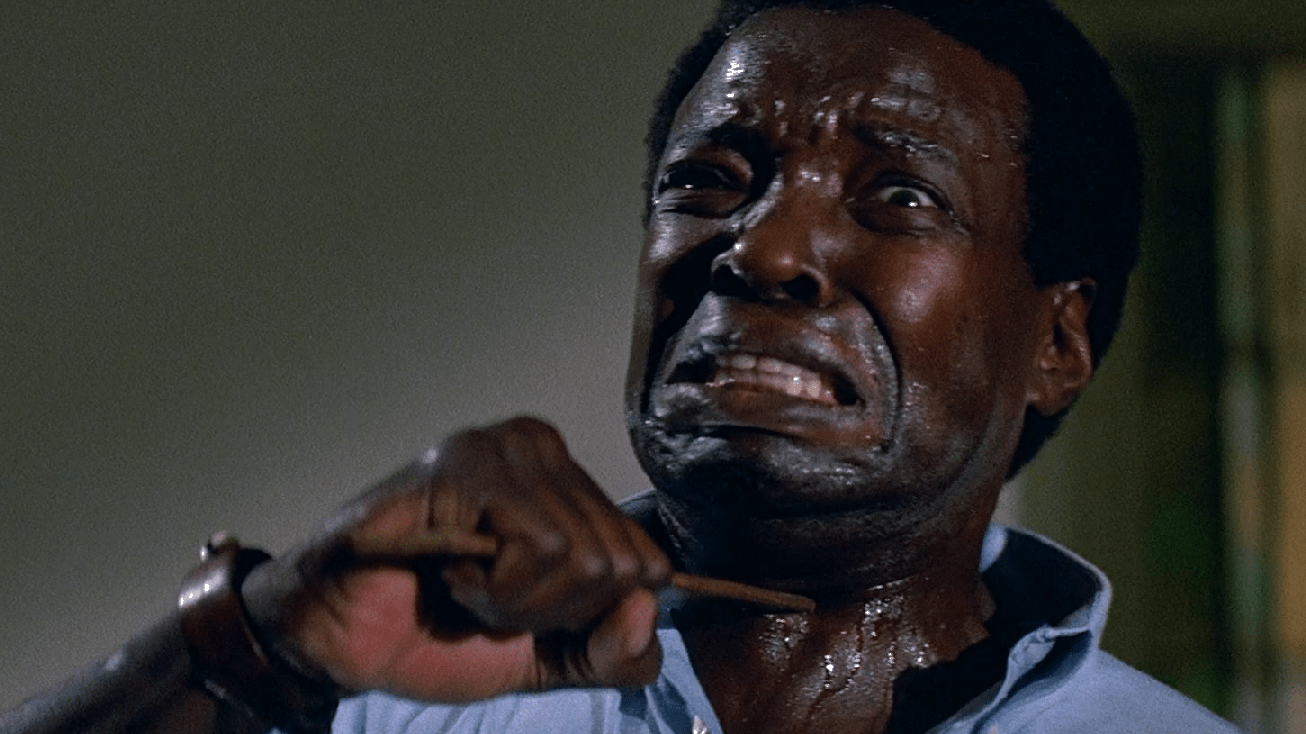
And it’s at this point in the movie when the glowing green ooze OPENS ITS OWN CONTAINER and starts spraying itself at people, right into their mouths. After they choke on the slime for a while, it takes complete control of their bodies, effectively “possessing” them. This explains what happened to all the zombified homeless people lurking outside the church, and why they butcher anyone who tries to leave. Being dead does not prohibit the slime from possessing its hosts either, for several of the scientists’ mangled corpses are converted into zombies as well. Most of the ooze absorbs itself into one scientist in particular, sending the poor lady into a coma. The remaining survivors are trapped inside the church for the entire following day, unable to call or send anyone out for help.

As night falls on the second day at St. Goddard’s, Satan’s primary host—who is now horribly disfigured and equipped with fierce telekinetic powers—awakens from her coma. The Prince of Darkness then transforms every mirror in the building into some kind of interdimensional gateway. On the other side of each gateway lurks the Anti-God, which is anxious to step back into this world and start the apocalypse. Just what the hell can Brian, Catherine, Walter, Birack, or the Priest do to stop any of this insanity? I ain’t gonna tell you; go watch the movie to see!
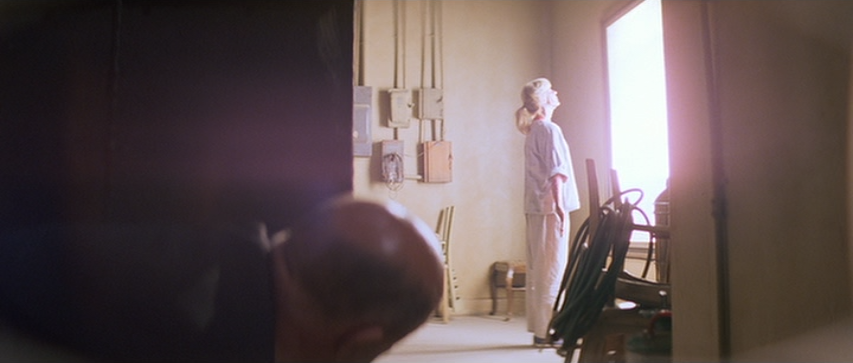
Without a doubt, Prince of Darkness is the most inventive and thought-provoking “devil movie” I have ever seen. Carpenter wrote the script under the pen name “Martin Quatermass,” which is an obvious homage to Nigel Kneale. (He even named the fictional college after his hero, calling it Kneale University.) The premise is very similar to Quatermass and the Pit (1967), in which another team of scientists battles a similar alien force that is likewise revealed to be “the scientific reality” behind a supernatural force. I think the concept for Prince of Darkness might have originated from when Carpenter was still involved with Halloween 4 (1988) during its pre-production phase. He had pitched a script by Dennis Etchinson in which Michael Myers returns as some kind of reality-bending ghost. When this premise for Halloween 4 was rejected, Carpenter reworked it into the script that later became Prince of Darkness. (He even wrote in a character named “Etchinson,” who is clearly named after the horror novelist.) Carpenter was also reading tons of shit about quantum mechanics at the time, and all of this stuff collided together in his brain to form the idea of a cosmic supervillain: the all-powerful Anti-God.
If it seems unlikely that Prince of Darkness came from a rejected pitch for a Halloween sequel, just look at the Priest. He is functionally similar to Dr. Loomis from Halloween (1978) in almost every way; the Wise Elder who knows about the Evil, and who tries to do something about it. He even refers to Satan as his “prisoner” at various points, as if he were Dr. Loomis referring to Michael Myers. It also seems relevant that Carpenter chose not to give this character a name. When you watch Prince of Darkness with subtitles, the captions identify the Priest as “Father Loomis” for some reason (even though he is never addressed by name, not even in the end credits). Based on Pleasence’s performance here, I almost think Prince of Darkness is actually a direct sequel to Halloween from some alternate timeline. Perhaps in this cinematic universe, Dr. Loomis gave up on psychiatry after shooting the Shape at the end of Halloween, then launched a new career for himself in the Catholic Church. But now he is tasked with handling yet another unstoppable prisoner, and this one is even worse than the last!
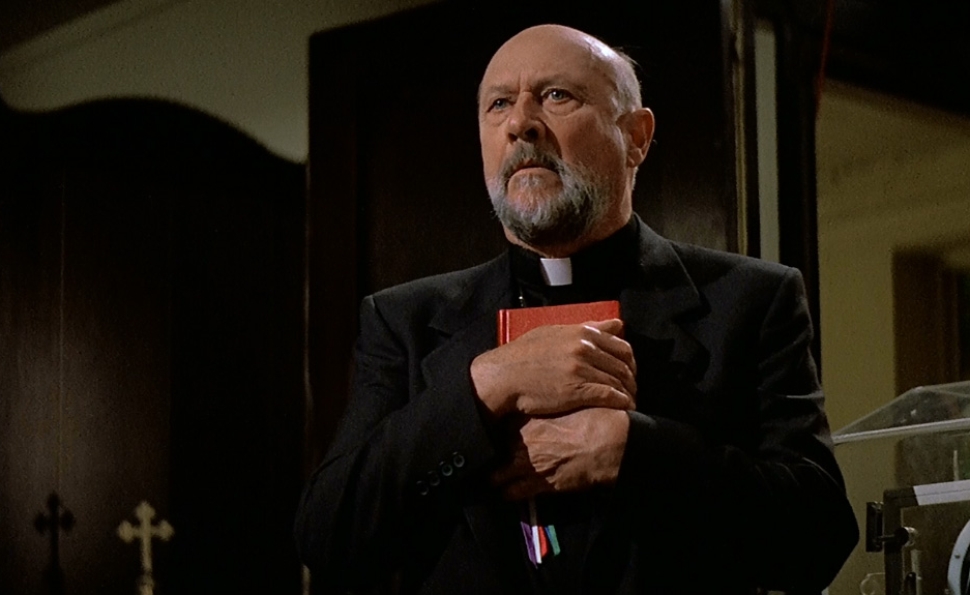
Pleasence gives one of his very best performances here. When the truth about Satan is revealed, the Priest quickly accepts that the Catholic Church and its teachings are all a sham. But we can also see the terrible strain this knowledge puts on him. When the Priest hides from one of Satan’s hosts, he stands there quietly, whispering desperate prayers to his God. You can see on his face that he doesn’t really believe in who he’s praying to anymore. Something about Pleasence’s voice during that scene always makes me want to reach through the TV and tell him, “It’s gonna be all right, Father; let’s invoke SET into ourselves and BLUDGEON these slimy zombie fuckers SIX WAYS FROM SUNDAY!” Yet the Priest never becomes a problem or a liability for the other characters; he is nothing like Blair from The Thing (1982), who just totally loses his shit and tries to kill everybody. The Priest clearly isn’t having an easy time with any of this “Space Jesus” stuff; but his heart is still in the right place, and he does his best to stay useful and sane.
Another actor who is truly fantastic in this film is Victor Wong. You’ve probably seen this guy in tons of movies, but he also appears in John Carpenter’s Big Trouble in Little China (1986) as the benevolent kung-fu wizard, Egg Shen. Wong is another character actor who was generally cast to play the exact same role in everything he did, usually appearing as a monk, seer, or martial arts master (as seen in films like The Golden Child from 1986 and Three Ninjas from 1992). But Prince of Darkness is one of the few films I’ve ever seen in which Wong is not typecast in this way at all. Here he gets to be a Gods-damn quantum physicist, a role that would have normally been reserved for a white male back in 1987. Professor Birack is also one of the main characters, which is especially meaningful since Wong was typically cast only for supporting roles. As a matter of fact, Prince of Darkness features not one but two Wise Elders who know about the Evil and are trying to stop it: Birack and the Priest.

As a Pagan, one of my biggest pet peeves in science fiction is the conflation of Pagan deities with “ancient astronauts.” We see this trope again and again in things like Doctor Who, Stargate, and any number of other media fandoms. This notion stems from the white colonialist belief that other cultures simply “couldn’t” have accomplished their own achievements by themselves. To claim the pyramids were built by aliens rather than the ancient Egyptians, for example, is to claim the Egyptians were not as smart or resourceful as the Greeks or Romans (who are almost never accused of having anything “provided” for them by aliens, likely because they were white). The Egyptians were a highly advanced people and they did not need any help from extraterrestrials to develop their religion, their art, their fantastic monuments, or anything else.
Almost no one EVER writes this kind of bullshit about Jesus Christ, and we know exactly why that is, don’t we? Because if anyone did, Christians would get all butt-hurt about people dehumanizing their beliefs and traditions. For some reason, this never seems to apply to other deities and religions; writers dehumanize Pagan beliefs and traditions ALL THE FUCKING TIME. But John Carpenter’s Prince of Darkness gets revenge for this by unabashedly “alienizing” Christianity, giving Jesus and Yahweh the exact same treatment that things like Doctor Who give to Set!
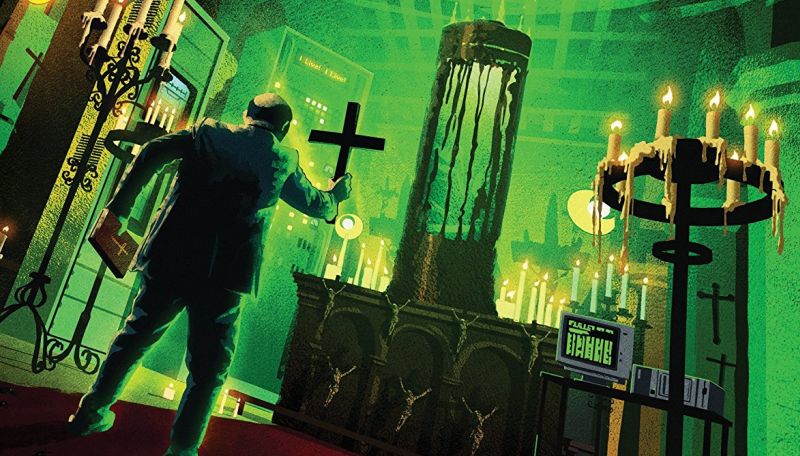
(Incidentally, there are at least two other films I know of that “alienize” Jesus like this. One is Giulio Paradisi’s The Visitor [1980], which is just awful, and another is Larry Cohen’s God Told Me To [1976], which is actually pretty terrific. But neither of these films holds a candle to Prince of Darkness.)
I enjoy the fact that Carpenter completely deconstructs Christian mythology here. Compare Prince of Darkness to End of Days (1999), for example. The latter is an A-list, big budget exploitation movie that only exists to satisfy the demand for sex and violence. There’s nothing wrong with this in principle, but End of Days also tries to pass itself off as a “religious” movie that wants to “scare you back into church.” In Prince of Darkness, no sanctimonious lip service is paid to Christianity whatsoever; the entire religion is written off as simply being false. Absolutely none of the traditional Christian weapons against Satan (crucifixes, exorcisms, etc.) will work. The message I take from this film is, “God is EVIL, and the only way to stop him is with SCIENCE!” If End of Days wants you to get your ass to church, Prince of Darkness wants you to get your ass to a quantum physics classroom.

As a Setian, this film speaks to me very deeply, and in at least two different ways. It’s intriguing to think that Satan himself is not the true source of evil here, but just a facilitator for an even greater and more powerful villain. The Anti-God might as well be Apep from Kemetic mythology: an unstoppable disintegrator of reality that can be repelled, but which can never be completely defeated. It’s very easy for me to imagine the Brotherhood of Sleep and its new recruits (the Priest and the scientists) as a constellation of souls chosen by Set to try and cast this monster back into the void. On the other hand, the film also speaks to me in terms of my own religious conversion, in which I realized:
- There is this thing in my life that I would call a God.
- This God I experience defies everything I was told about “God” as a child.
- Conventional religion just can’t seem to handle this God, because He scares most religious people too much.
So watching Prince of Darkness, in which the characters make these exact same discoveries about the Anti-God, really made an impression on me. The movie seemed to tell me, “Yes, G.B., it’s totally okay for you to THINK BEYOND CHRISTIAN IDEOLOGY!” When people around me learned of my love for Set, many of them insisted I was “worshiping the devil” and would “burn in hell.” (Some people still tell me this today.) Prince of Darkness helped me break out of this mental trap by reinforcing the idea that there CAN be higher cosmic realities that defy conventional religious expectations. This helped me come to terms with Set’s true identity as a Kemetic Netjer and understand that He is not, in fact, “the devil.” It also helped me understand that I am a Setian and a Kemetic polytheist, not a Satanist or a devil worshiper.

As a final note, John Carpenter typically scores most of his own films, and Prince of Darkness is no exception. The movie features 50 minutes or so of eerie electronic music by Carpenter and his frequent collaborator at the time, Alan Howarth. This score is haunting and beautiful, perfectly capturing the threat of total cosmic decay. Before I started composing my own tunes, this was one of my favorite albums to play during my rituals to Set. It has definitely been a major influence on my latest release, His Nocturnal Majesty, and I highly recommend it to anyone who enjoys my work.
